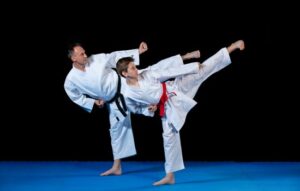Karate Training
★ 3.4Information on size, installation and warranty may vary as updates are made in official stores.
In a world where personal safety and physical well-being are becoming increasingly important, knowing how to defend yourself karate-style becomes a valuable skill. As a successful marketing professional, I've explored various free apps available to learn karate-based defense techniques, all from your mobile phone.
My goal with this analysis is to help you understand what to look for, how to choose, what limitations exist, and which apps really stand out if you want to start training without paying. This way, you'll be able to make informed decisions that boost your personal and professional development. 🥋
Importance of learning karate for self-defense
Self-defense goes beyond knowing how to fight; it means having confidence, discipline, self-control, and the ability to react. In marketing, for example, we learn that a strong brand not only offers products but also inspires confidence. Similarly, a person who understands the principles of karate conveys presence, seriousness, and respect.
In addition, karate teaches:
- Mental discipline: control emotions, maintain concentration.
- Physical strength and coordination: improve agility, posture, balance.
- Self-discipline: training habit, consistency.
- Intelligent self-protection: techniques to avoid harm, to escape from dangerous situations, not just to confront.
And the important thing: many people today have little time to attend in-person classes, but they do have a mobile phone that's always with them. This makes apps very attractive options—and free if you choose wisely.
What to look for in a free karate learning app
As a marketer who analyzes digital products, these are the criteria I consider essential for evaluating karate-based self-defense mobile apps:
- Quality of pedagogical content
Techniques should be explained by experts, with clear videos or animations, with logical progression: basic movements, guards, blocks, kicks, combinations. - Safety and responsibility
It should emphasize injury prevention, safe use of techniques, and warnings against dangerous practices. Learning a "shocking" move without support is not the same as learning it with clear instruction. - Interface and user experience
Make sure menus are clear, with step-by-step instructions, local language translation if possible, and easy controls. Avoid apps full of intrusive ads that interrupt lessons. - Compatibility and operation at no cost
It works on current versions of Android and iOS, doesn't require mandatory payments for essential items, and allows you to download content offline or watch lessons without needing a constant connection. - Feedback and follow-up
Ideally, the app allows you to record progress: techniques you've already learned, exercises completed, levels, and goals. This motivates you to continue and improves learning retention. - Reputation, reviews, community
See reviews from those who already use the app, see how many downloads it has, how many active users it has, if there's a forum or support, and even watch videos of users showing their progress.
SEO: How to Search and Find Effective Apps
For those of us who manage digital strategies, like me, knowing how other people search is key. If you plan to write a blog, make videos, or share reviews, using keywords that people actually use is vital. Some ideas:
- “free karate self-defense app”
- “Learn karate on your mobile for free”
- “karate self-defense techniques app”
- “Basic karate exercises app Android/iPhone”
- “How to start karate without going to the dojo”
It's also a good idea to create content such as "step-by-step tutorials," "app comparisons," "real reviews," "success stories," and "common mistakes." This improves SEO ranking because many people prefer to read real-life experiences, see images, and reviews. Using headings (H1, H2, etc.), short paragraphs, lists, and moderate emojis also improves readability and reader retention.
Common limitations of free apps
Not all that glitters is gold. Even the most well-regarded apps have restrictions:
- Free versions only show partial content: first levels, simple techniques, no advanced combinations.
- Ads interrupting lessons, lack of offline options, and constant connection requirements.
- Lack of customization: Some users need to adapt movements based on age and physical condition; not all apps offer modifications.
- Lack of live feedback: There's no teacher to correct mistakes; using only the screen can lead to incorrect posture or minor injuries.
- Language or interface barriers: If the app is only in English or another language, it can make learning difficult.
Therefore, choosing the right app means knowing what to expect, being patient, practicing safely, and, if possible, supplementing with real-life classes, even if only occasionally.
How to use apps correctly to maximize results
To really benefit from a free app and learn defensive karate, these steps will help:
- Establish a fixed weekly schedule
Even if it's just 15-30 minutes a day, consistency overcomes high initial intensity. - Start with the basics
Stance (kamae), guard, blocks (uke), basic strikes (tsuki), simple kicks (geri). Don't skip levels: each technique builds on the previous one. - See and memorize before practicing
Watch videos and animations; then practice in front of a mirror or record yourself to check your posture; use kinesthetic imagination. - Conscious repetition
Don't just repeat it over and over, but carefully: what part of the body is being moved, where the shoulders, feet, and hips are. Always make corrections. - Safety first
Avoid hard surfaces where falling would be too painful; use adequate space; warm up well; listen to your body. - Record progress
Keep track of which techniques you've mastered, which ones need more practice, session times, and progress. This helps maintain motivation.
Featured applications after evaluating criteria
Now that we're halfway through the review, I want to share a few apps that do a pretty good job of what I've described and can really serve as a starting point. 🌟
- Karate Combat Training
This free app offers structured classes from basic movements to combination defenses. It features high-quality videos, progressive levels, and allows you to watch lessons offline. Ideal if you're starting from scratch. - Martial Arts Self Defense Coach
It focuses specifically on self-defense using karate principles: blocks, dodges, and escape movements. It includes practice reminders, interactive diagrams, and safety tips. - Karate Dojo Interactive
It offers a very clear interface, with modular lessons, explanatory videos, technique charts to see the trajectory of punches and kicks, and feedback through integrated quizzes to ensure understanding. - Learn Karate Basics Free
Focused on the fundamentals: stance, straight and roundhouse punches, front and side kicks, and blocks. Perfect for those looking for a solid foundation before moving on to more complex combinations.
Each of these apps has free versions with paid options for premium content, but to get started and learn the basics, the free version is very useful.
Comparison between applications and use cases
Here's a summary table with examples of which app to choose based on your situation:
| Personal/professional situation | Recommendation | Why this option |
|---|---|---|
| You have never practiced karate | Learn Karate Basics Free | Focus on fundamentals, no technical overload |
| You want to use real defensive moves | Martial Arts Self Defense Coach | Focuses on escape techniques. |
| Disability or limited mobility | Karate Dojo Interactive | Modular lessons, tight pace, clear explanation |
| You need offline content due to lack of internet | Karate Combat Training | Allows you to download lessons for offline practice |
Real benefits I have observed
As a marketing professional who also practices sports and values holistic health, I can share some real benefits of using these apps:
- Improvement of the self-confidence by learning that one can react to minimal threats.
- Better body posture and coordination, which also impacts how we appear to clients, social media, and meetings: you project more authority.
- Increased discipline, which translates to work, goal achievement, and time management.
- Gradual sense of accomplishment: completing modules, unlocking techniques, seeing visual improvement when looking in the mirror or at photos/videos of yourself.
How to promote these types of apps (if you are a creator or marketer)
If your role is to promote these apps, using these points can make all the difference:
- Create video demonstrations showing before and after learning.
- Testimonials from users who used them for free and improved their physical capacity/personal security.
- Supplemental educational content: Blogs with safety tips, common practice mistakes, and how to avoid injuries.
- Use social media to show micro-tutorials; for example, a blocking technique quickly visualized on Reels or TikTok, citing your favorite app.
- Offer weekly challenges: “Learn this block in 3 days,” “Practice these basic kicks,” etc.
SEO applied to content on self-defense and karate
If you're writing about these apps or want your content to be easily found on Google and app stores, consider:
- Use titles with keywords like “learn karate for free,” “self-defense app,” “free karate for beginners.”
- Include subtitles with frequently asked questions: “Can an app really teach karate?”, “Do I need an instructor?”, “What is the difference between the free and premium versions?”
- Meta-descriptions that summarize what the app offers: “Free karate app with basic lessons, offline, no mandatory payments”
- Own images or screenshots with permission, showing the app interface, movements, progress.
- Local SEO if your audience speaks Spanish from Latin America or Spain: mention words like “personal safety movements Latin America,” “Karate Mexico,” “karate Spain.”
Warnings and ethics in learning karate via app
As a conscious professional, it is also key to note:
- They don't completely replace a qualified instructor. The app is useful for beginners or as a supplement, but in-person practice provides personalized correction.
- Do not use aggressive techniques except in self-defense. Legal liability may vary by country.
- Avoid demonstrating defensive techniques in unsafe or improvised situations. Sometimes it's best to avoid confrontation.
- Recognize personal limitations: If you are injured, have a medical condition, or joint problem, it is best to consult a professional before practicing certain movements.
Time estimates for progress
Although each person progresses differently, you can use these references:
- 1 to 2 weeks: familiarize yourself with stance, basic guards, simple blocks.
- 3 to 4 weeks: : perform weak combinations, straight punches/front kicks, simple dodges.
- 2 to 3 months: more dynamic movements, mixed techniques, constant practice, a certain fluidity.
If you do three 20-30 minute sessions a week with the free app, you'll see visible progress within a month.
See also:
- Free apps successfully recover deleted photos
- Free tarot apps surprise users 🔮📱
- New free apps revolutionize mechanical learning
- Free tarot apps surprise in 2025
- Free mobile apps teach automotive mechanics
Conclusion
In short, learning karate self-defense through free apps is a viable option, especially if you make informed decisions. Consider content quality, safety, reputation, and user experience; practice consistently, start with the basics, and be aware of the limitations. The apps I've mentioned can make a difference if you're truly committed.
If you'd like, I can send you an updated selection of free karate apps in Latin America in 2025, with real-life screenshots, comparisons of free vs. premium features, and rankings of Spanish-speaking users. Can I prepare it for you? 💪






